UNBC Nursing professors research implications of physician-assisted death in rural communities

From left: UNBC nursing professors Catharine Schiller and Dr. Shannon Freeman.
In February 2015, the end-of-life landscape in this country underwent dramatic change. The Supreme Court of Canada unanimously ruled that competent adults who are experiencing unbearable suffering as the result of a serious, incurable medical condition could legally seek out a physician-assisted death.
One province, Quebec, has already implemented its own end-of-life legislation while other provinces, such as Alberta, are currently conducting public input campaigns on the issue. B.C’s Minister of Health, Terry Lake, has said that he will not develop BC-specific policies or provincial legislation until the federal government develops its legislation on the matter. In January, the Supreme Court of Canada decision extended the deadline for the federal government to implement such legislation to June 2016.
Two faculty members in UNBC’s School of Nursing are currently researching the implications of physician-assisted death for nurses in rural communities. Dr. Shannon Freeman, an assistant professor at UNBC’s School of Nursing, recently published an article in BioMed Central that states in the “pursuit to provide the highest quality of person centered palliative care, client preferences, needs, and wishes surrounding end of life should be used to inform the plan of care.”
Catharine Schiller, a lawyer, nurse and assistant professor in UNBC’s School of Nursing, is also exploring this issue and will be presenting at conferences on the potential implications of the Supreme Court decision for nurses and for the broader healthcare system.
Dr. Freeman led the first study using data gathered from the interRAI Palliative Care Assessment instrument (interRAI PC), a standardized assessment instrument currently mandated for use among palliative homecare clients in Ontario and across other jurisdictions to examine socio-demographic, clinical, and psycho-social factors of palliative home care clients with the voluntary expression of a “wish to die now.”
Awareness and understanding of clients who express the ‘wish to die’ is needed to better tailor a person-centered approach to end-of-life care. It is important for those engaging in the physician assisted suicide debate to have a strong understanding of which Canadians are voluntarily expressing a ‘wish to die now.'
In her research, Dr. Freeman describes in depth a multidimensional picture of palliative home care clients who have expressed to their clinician, most often a nurse case manager, that they ‘wish to die now.’ For some of these clients, they exhibited psychological distress, depression, and pain while others showed less physical and cognitive impairment and reported that they had a positive outlook on life and that they had strengths which could be fostered.
“To provide a person centered approach to caring for persons faced with a life limiting illness, it is critical for nurses to care for the ‘whole person and to embrace not fear conversations with clients about their preferences for death,” says Dr. Freeman. “During a clinical assessment for care services, clients may voluntarily express a wish to die,” says Freeman. “This request may come either directly to the clinician or it may be indirectly reported second-hand to the clinician through a nurse, informal caregiver, or family member.
“Clients who expressed a ‘wish to die’ did not all experience pain, depression, and psychological distress, suggesting an individualized approach to care management be taken,” she adds.
During the clinical assessment of 4,840 palliative home care clients, 308 palliative home care clients (6.7%) had voluntarily expressed a “wish to die now.”
Persons at higher risk to express a ‘wish to die now’ were more likely to not be married/widowed, reported a shorter estimated prognosis, exhibited depressive symptoms, experienced functional impairment, reported sleeping excessive amounts, felt completion regarding financial/legal matters, and were struggling with the meaning of life.
Clients who expressed a “wish to die now” 23.8% also exhibited depressive symptoms. Among this group of clients who expressed a ‘wish to die now’ those who also exhibited depressive symptoms were significantly more likely to also be experiencing cognitive impairment, decline in cognition in the last 90 days, weight loss, not have a consistent positive outlook on life, and report “struggling with the meaning of life.”
When clients voluntary express a “wish to die,” clinicians should take notice and initiate follow-up to better understand the context of this meaning for the individual.